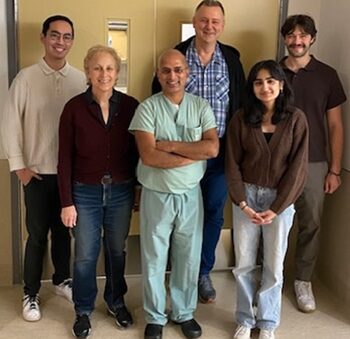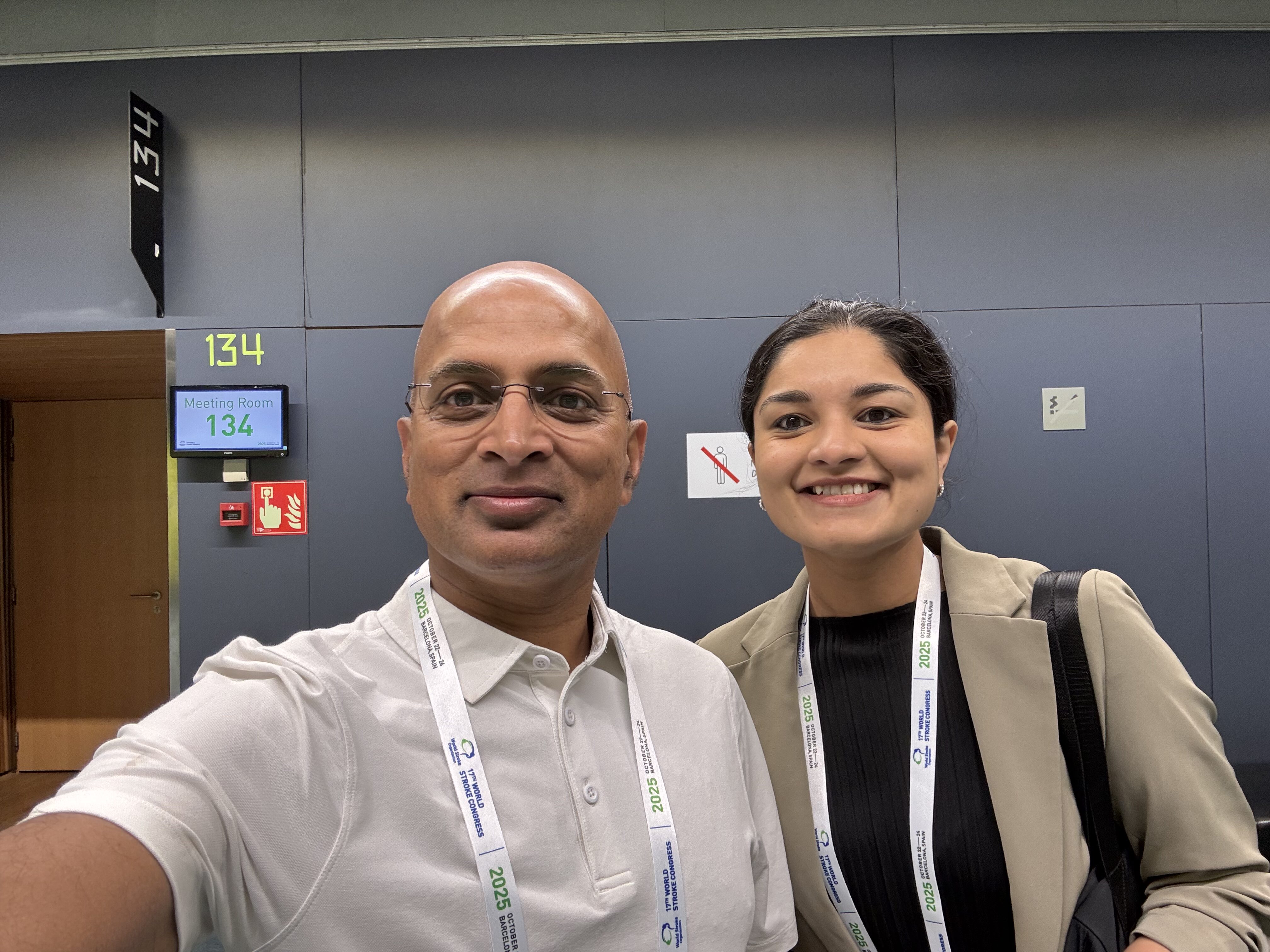Day 3 Clinical Trials Highlights at WSC 2025
RESCUE-RESS trial (XingNaoJing)
Prepared by Zhe Kang Law
Dr Xin Liu from Beijing Tiantan Hospital presented on RESCUE-RESS, a multicentre prospective randomised open-label blinded end-point (PROBE) phase 3 trial testing XingNaoJing (XNJ) in acute ischaemic patients who had EVT. XNJ is a brain cytoprotectant containing 4 herbs (musk, gardenia, cinnamon and camphor) with anti-inflammatory and antioxidant properties. Patient with acute ischaemic stroke who underwent EVT < 24hours and could be randomised within 24 hours of EVT were randomised 1:1 to receive intravenous XNJ 20mL q12hr for 10 days or best medical treatment.
The primary outcome was modified Rankin scale of 0-2 at day 90. Secondary outcomes include neurological deterioration, symptomatic ICH, final infarct volume and increase in NIHSS at day 14 or discharge as well as recurrent stroke, death and composite vascular events at day 90.
A total of 424 patients were enrolled with a mean age of 64 years, NIHSS of 13 with 73.82% having MCA occlusion. 33.25% of patients received intravenous thrombolysis, 82.55% had EVT and 35.14% had both IVT and EVT. Successful reperfusion with TICI 2b-3 was achieved in 95.75%.
However, the work is ongoing and results on outcomes were not presented.
This study was presented by Dr. Xin Liu at the World Stroke Organization (WSO) Conference, held on 24 October 2025 in Barcelona, Spain.
Prophylactic Levetiracetam for the Prevention of Post Stroke Seizures (PROLEVIS)
Prepared by Juen Kiem Tan
The PROLEVIS study was presented by Dr Meena Chandu. The PROLEVIS study was a multicenter, double-blind, placebo-controlled randomized trial, explored the role of prophylactic levetiracetam administration in stroke. The trial was conducted across six sites in India, between November 2018 and June 2025. Participants in the intervention arm received levetiracetam 250mg twice daily for one week, followed by uptitration to 500mg (if weight < 75kg) or 750mg (if weight > 75kg) twice daily for three months, in addition to standard of care treatment. The control arm received a placebo alongside standard of care treatment. The primary outcome was the occurrence of a clinical seizure within one year of stroke onset. Secondary outcomes included the time from stroke onset to first seizure, rate of early and late post-stroke seizure, functional outcomes at 3 and 12 months (based on mRS), adverse events and drug side effects, stroke recurrence and complications, and mortality at 3 and 12 months.
A total of 439 post-stroke patients within 14 days of onset were randomized, with 430 participants included in the modified intention-to-treat (mITT) population (215 each arm). Baseline characteristics were comparable between the two groups. The primary outcome showed no significant reduction in clinical seizures within one year of stroke onset in the mITT. Most seizures occurred early (within three months), with no difference between groups. Furthermore, no significant differences were observed in early or late post-stroke seizures, functional outcomes, stroke recurrence and complications, and mortality at 3 and 12 months. Aside from a slight increase in central nervous system symptoms, treatment-emergent adverse events were comparable between groups.
In conclusion, the study found no clear benefit to initiating prophylactic levetiracetam in the early post-stroke period.
This study was presented by Dr Meena Chandu at the World Stroke Organization (WSO) Conference, held on 24 October 2025 in Barcelona, Spain.
COMMIT study
Prepared by Zhe Kang Law
The COMMIT study was presented by Dr Iain McGurgan. This was a prospective population-based consequential comparison study, that explored the safety and effectiveness of early intensive blood pressure treatment after TIA and minor stroke. The patients studied were patients with TIA/minor stroke in Oxfordshire, UK who were referred to the Oxvasc Clinical Service run by Professor Peter Rothwell and his fellows. Prior to the COMMIT study, patients with TIA/minor stroke were given prescription for antiplatelet therapy and antihypertensive agents if needed after a rapid consultation and followed up in clinic one month later(Policy-2, 2004-2008). In the COMMIT study (Policy-3, 2008-2020), in addition to antiplatelet therapy, patients were given a home BP monitor and offered remote telemetric home blood pressure monitoring (RT-HBPM) with daily central physician review with intensification of BP treatment to <130/80 mmHg. Patients subsequently had a clinic follow-up at 1 month.
The introduction of RT-HBPM significantly reduced blood presssure at 1 month (127/72 mmHg vs 137/75 mmHg in Policy-2; p<0.0001). The risk of disabling or fatal stroke is reduced with the introduction of RT-HBPM (aHR 0.56, 95%CI 0.33-0.95). The risk of ICH was also significantly reduced (log-rank test p=0.017). There was also significant ordinal shift in modified Rankin Scale (p=0.015). The 5-year risk of ischaemic stroke and ICH were reduced with an aHR 0.62 (0.50-0.77) and aHR 0.48 (0.25-0.91) respectively.
In conclusion, an early and rapidly-intensified BP-lowering after TIA/minor stroke is safe when used with RT-HBPM. A policy of early control of BP substantially reduced early and long term risk of disabling and fatal stroke. This approach is acceptable to the patients and primary care doctors.
This study was presented by Dr Iain McGurgan at the World Stroke Organization (WSO) Conference, held on 24 October 2025 in Barcelona, Spain.
EMMA-CAN: A Canadian Multicenter Randomized Trial Evaluating Middle Meningeal Artery Embolization for Chronic Subdural Hematoma in Canada
Prepared by FSL Dr. Nishita Singh
The EMMA-CAN trial is the first Canadian multicentre randomized controlled study to evaluate embolization of the middle meningeal artery (EMMA) as an adjunct to surgery for patients with unilateral chronic subdural hematoma (CSDH). This condition, increasingly common among older adults, carries high recurrence rates following burr-hole drainage and is projected to become the most frequent adult neurosurgical diagnosis by 2030.
Led by Dr. Jai Shankar at the University of Manitoba, EMMA-CAN enrolled 192 patients across eight tertiary centres from August 2021 to April 2025. Participants were randomized to receive either standard surgical care alone or surgery plus EMMA performed within 72 hours post-operation using a liquid embolic agent (Onyx-18). The primary endpoint was radiographic or symptomatic recurrence of CSDH at 90 days, assessed by blinded central adjudication.
Results showed that radiographic recurrence was reduced more than threefold (6.5% with EMMA vs 22.8% with standard care), while symptomatic recurrence was nearly six times lower (2.2% vs 14.8%). Rates of serious adverse events (7.6% EMMA vs 8.1% control) and mortality at 90 days (2.2% EMMA vs 2.3% control) were comparable, with no events directly attributed to the embolization procedure.
These findings provide the first randomized Canadian evidence that EMMA, when added to surgery, is safe and significantly reduces hematoma recurrence in patients with chronic subdural hematoma. EMMA-CAN highlights the capacity for high-quality, investigator-initiated neurointerventional research across Canadian academic centres and paves the way for integration of this minimally invasive technique into standard care. Extended one-year follow-up and real-world registry data are underway to assess long-term durability and generalizability of results.
This study was presented by Dr. Jai Shankar at the World Stroke Organization (WSO) Conference, held on 24 October 2025 in Barcelona, Spain.


The Randomized, Double-blind, Placebo-controlled, Phase 3 FOCUS Study of Ganglioside GM1 for Acute Ischemic Stroke (AIS)
Prepared by Juen Kiem Tan
The FOCUS study was a multicenter, double-blind, placebo-controlled, randomized phase 3 trial evaluating the efficacy and safety of monosialotetrahexosylganglioside (GM1) as a neuroprotective agent in patients with acute ischemic stroke (AIS). The trial included participants with AIS attributable to internal carotid artery occlusion, with symptom onset within 24 hours, a baseline NIHSS score of 7-20, and a premorbid mRS score of ≤1 in the event of recurrent AIS. Participants were randomized into two groups: the GM1 group received conventional therapy plus GM1 100 mg daily for 12–14 days, while the placebo group received conventional therapy plus a placebo for the same duration. The primary endpoint was the proportion of patients achieving an mRS ≤2 at 90 days, while secondary endpoints included mRS ≤1 at days 14, 30, and 90.
A total of 1,368 patients were screened, with 1,203 participants randomized and included in the interim analysis (601 in the GM1 group and 602 in the placebo group). Baseline characteristics were balanced between groups. At day 90, the primary outcome showed that significantly more patients achieved functional independence (mRS ≤2) in the GM1 group compared to the placebo group (67.7% vs. 57.5%; RD 10.16%, 98.78% CI 2.70%–17.61%; p = 0.0007). This prompted early termination of the trial. For secondary outcomes, the GM1 group demonstrated superiority for achieving mRS ≤1 at day 90 (RD 6.63%, 95% CI 0.58%–12.69%; p = 0.0313), although no significant improvements were observed at days 14 and 30. Regarding safety, the incidence of adverse events was similar between groups, with no treatment-emergent adverse events reported, including Guillain-Barré syndrome.
In summary, GM1 significantly improved functional outcomes at 90 days in AIS patients compared with placebo, with a favorable safety profile.
This study was presented by Dr. Xin Zhang at the World Stroke Organization (WSO) Conference, held on 24 October 2025 in Barcelona, Spain.
IAT-TOP trial
Prepared by Zhe Kang Law
IAT-TOP trial was presented by Dr Raul Nogueira. This was a multicentre, prospective RCT with a PROBE design conducted in 31 centres in China. Key inclusion criteria are basilar artery or vertebral artery occlusion without anterograde flow to basilar artery, pc-ASPECTS of 6-10, post-procedural eTICI≥2b50 and no more than 2 thrombectomy passes. Participating centres had to perform ≥ 100 cases of thrombectomy/year and participating operator performed ≥ 20 cases per year.
The patients were randomised 1:1 to receive intraarterial alteplase at a dose of 0.225mg/kg infused at 1mg/mL over 15 minutes, distal to the origin of posterior inferior cerebellar artery or best medical treatment. The primary outcome was modified Rankin Scale of 0-2 at 90 days. Secondary outcomes were changes in eTICI after intraarterial thrombolysis (IAT), mRS 0-1 at 90 days and early neurological improvements at 48 hours. Safety outcomes were any ICH at 48 hours and all- cause mortality at 90 days.
Between April 2023 till February 2025, 247 patients were enrolled (125 IAT and 122 control) before early termination due to futility. There was no difference in the primary outcome of mRS 0-2 (41.9% in IAT vs 46.7% in control; RR 0.90, 95% CI 0.68-1.19; p=0.55). There was no significant interaction in all subgroup analyses. All secondary outcomes were non-significant as well. There was no significant difference in mild, moderate or severe bleeding.
Possible explanation for the neutral results was an unexpectedly high functional independence rate in the control group (46.7%) and use of rescue therapy of angioplasty and stenting which may have obscured treatment benefit.
In conclusion, in patients with acute ischaemic stroke due to large vessel occlusion in the posterior circulation who achieved successful endovascular recanalisation, adjunctive intra-arterial alteplase was safe but did not improve functional outcome at 90 days.
This study was presented by Dr. Raul Nogueira at the World Stroke Organization (WSO) Conference, held on 24 October 2025 in Barcelona, Spain.